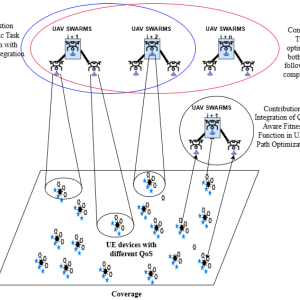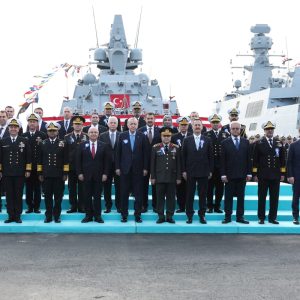Russian’s New Multipurpose UGV is now entering an intensive phase of field testing, marking a significant milestone in its development. This article delves deep into the intricacies of these cutting-edge vehicles, their technological advancements, and the implications for global military strategy.

Technological Innovations in Russian UGVs
Advanced Autonomous Navigation Systems
One of the core strengths of Russian UGVs lies in their autonomous navigation systems. These vehicles are equipped with sophisticated sensors, including LIDAR, RADAR, and optical cameras, which allow them to navigate complex environments with high precision. The integration of machine learning algorithms enables these UGVs to learn and adapt to new terrains, enhancing their operational efficiency.
Robust Communication Networks
Effective communication is paramount in modern military operations. Russian UGVs are fitted with state-of-the-art communication systems that ensure seamless data transmission between the vehicle, command centers, and other units. This is achieved through secure, encrypted channels that resist electronic warfare tactics, maintaining the integrity of mission-critical information.
Versatile Payload Capabilities
The multipurpose nature of these UGVs is exemplified by their ability to carry diverse payloads. They can be equipped with surveillance equipment, combat systems, logistics support tools, and medical evacuation modules. This versatility allows a single UGV platform to perform various roles, reducing the logistical footprint and enhancing mission flexibility.
Enhanced Mobility and Durability
Russian UGVs are designed to operate in harsh environments. Their all-terrain mobility is supported by robust suspension systems, powerful engines, and adaptive wheel/tracked configurations. Additionally, their durable construction ensures they can withstand extreme temperatures, rough terrain, and physical impacts, making them reliable assets in challenging operational contexts.
Field Testing: Objectives and Methodologies
Realistic Combat Scenarios
The primary objective of field testing is to evaluate the performance of UGVs in realistic combat scenarios. This involves deploying them in environments that mimic actual battlefields, where they must navigate obstacles, engage targets, and execute complex maneuvers. These tests assess the UGVs’ combat readiness, response times, and decision-making capabilities under pressure.
Integration with Human Units
Field testing also focuses on the integration of UGVs with human soldiers. This involves training personnel to operate and coordinate with UGVs, ensuring seamless cooperation during missions. The testing phase examines how well UGVs can support infantry units, provide reconnaissance, and deliver supplies in real-time, enhancing the overall effectiveness of human-robot collaboration.
Stress Testing and Reliability Assessments
To ensure that UGVs can perform reliably under extreme conditions, they undergo rigorous stress testing. This includes temperature tolerance tests, shock and vibration assessments, and waterproofing evaluations. By pushing the vehicles to their limits, developers can identify potential weaknesses and refine the designs to enhance durability and performance.
Cybersecurity Evaluations
Given the increasing threat of cyber warfare, the cybersecurity of UGVs is a critical aspect of field testing. These evaluations involve subjecting the vehicles to simulated cyber-attacks to test the robustness of their defensive measures. Ensuring that UGVs can resist hacking attempts and maintain operational integrity is crucial for their deployment in modern conflict zones.
Strategic Implications for Global Military Operations
Force Multiplication
The deployment of UGVs represents a significant force multiplier for military operations. Their ability to perform tasks traditionally handled by human soldiers allows for more efficient allocation of personnel. UGVs can undertake high-risk missions, reducing casualties and preserving human resources for strategic roles.
Enhanced Reconnaissance and Intelligence Gathering
UGVs equipped with advanced surveillance technologies play a pivotal role in reconnaissance and intelligence gathering. They can operate behind enemy lines, providing real-time data on enemy positions, movements, and fortifications. This information is invaluable for planning and executing tactical operations, giving military forces a strategic edge.
Logistical Efficiency
The logistical support capabilities of UGVs streamline supply chains in combat zones. They can autonomously transport ammunition, medical supplies, and other essential materials to frontline units. This reduces the burden on human personnel and ensures that troops have the resources they need to sustain prolonged engagements.
Combat Support and Offensive Operations
In combat support roles, UGVs can provide direct fire support, engage enemy targets, and even execute pre-programmed offensive maneuvers. Their precision and ability to operate in hazardous environments make them effective in neutralizing threats while minimizing collateral damage. This enhances the overall combat effectiveness of military units.
Challenges and Future Developments
Technological Limitations
Despite their advanced capabilities, current UGVs face technological limitations that must be addressed. These include battery life constraints, sensor accuracy in adverse conditions, and autonomous decision-making in highly dynamic environments. Ongoing research and development efforts aim to overcome these challenges, paving the way for more robust and reliable UGVs.
Ethical and Legal Considerations
The deployment of autonomous military vehicles raises important ethical and legal questions. Issues such as the rules of engagement for autonomous systems, accountability for actions taken by UGVs, and the potential for unintended consequences must be carefully considered. Developing clear guidelines and regulations is essential to ensure the responsible use of UGVs in combat.
Interoperability with Existing Systems
Integrating UGVs with existing military infrastructure and systems poses significant challenges. Ensuring that UGVs can communicate and operate seamlessly with manned vehicles, command centers, and other technological platforms is crucial for maximizing their effectiveness. Standardizing communication protocols and developing interoperable systems are key areas of focus for future development.
Training and Adaptation
Adapting military personnel to work effectively with UGVs requires comprehensive training programs. Soldiers must be trained not only to operate these vehicles but also to understand their capabilities and limitations. Developing training modules and simulation environments that mimic real-world scenarios is essential for preparing troops for the integration of UGVs into their operations.
Case Studies and Real-World Applications
Syrian Conflict: UGVs in Urban Warfare
The Syrian conflict has provided a testing ground for the deployment of Russian UGVs in urban warfare. These vehicles have been used for reconnaissance missions, bomb disposal, and direct combat support. Their ability to navigate narrow streets, enter buildings, and engage targets in densely populated areas has demonstrated their effectiveness in urban combat scenarios.
Arctic Operations: Adapting to Extreme Conditions
Russia’s military operations in the Arctic region have highlighted the adaptability of UGVs to extreme conditions. These vehicles have been tested in sub-zero temperatures, navigating ice and snow-covered terrains. Their successful operation in such harsh environments underscores their potential for deployment in other challenging regions, enhancing the military’s operational reach.
Border Security: Enhancing Surveillance and Patrolling
Russian UGVs have also been deployed for border security operations. Equipped with advanced surveillance equipment, these vehicles patrol borders, monitor for illegal activities, and provide real-time intelligence to border control units. Their autonomous patrolling capabilities reduce the need for human presence in remote and potentially dangerous areas.
Future Prospects and Innovations
Artificial Intelligence and Machine Learning Integration
The future of UGV development lies in the integration of artificial intelligence (AI) and machine learning (ML) technologies. These advancements will enable UGVs to make more sophisticated autonomous decisions, improving their ability to adapt to dynamic environments and unforeseen challenges. AI-driven UGVs will possess enhanced situational awareness, enabling them to operate more effectively alongside human soldiers.
Swarm Technology
Swarm technology represents a significant leap forward in UGV capabilities. By coordinating multiple UGVs to operate as a cohesive unit, military forces can achieve greater operational efficiency and effectiveness. Swarm-enabled UGVs can cover larger areas, execute complex maneuvers, and perform synchronized attacks, providing a substantial tactical advantage.
Hybrid Power Systems
To address the limitations of current battery technology, future UGVs may incorporate hybrid power systems. Combining traditional fuel engines with advanced batteries will extend the operational range and endurance of these vehicles. This hybrid approach will ensure that UGVs can sustain longer missions without the need for frequent recharging or refueling.
Advanced Defensive Measures
As UGVs become more integral to military operations, the development of advanced defensive measures will be crucial. This includes the integration of active protection systems (APS) to defend against anti-tank weapons, electronic countermeasures to disrupt enemy communications, and stealth technologies to reduce their detectability. Enhancing the survivability of UGVs will ensure their continued effectiveness on the battlefield.
Collaborative Human-Robot Teams
The concept of collaborative human-robot teams is an exciting prospect for the future. By leveraging the strengths of both human soldiers and UGVs, military forces can execute more complex and coordinated operations. Training programs that focus on building synergy between humans and robots will be essential for realizing the full potential of these collaborative teams.
Conclusion
The entry of Russian multipurpose unmanned ground vehicles into field testing marks a pivotal moment in the evolution of military technology. These advanced vehicles offer unparalleled capabilities in terms of autonomous navigation, communication, versatility, and durability. As they undergo rigorous field testing, their performance in realistic combat scenarios, integration with human units, and resilience under extreme conditions will be thoroughly evaluated.
The strategic implications of UGVs for global military operations are profound, promising enhanced force multiplication, improved reconnaissance and intelligence gathering, logistical efficiency, and robust combat support. However, challenges such as technological limitations, ethical considerations, interoperability issues, and the need for comprehensive training programs must be addressed.










